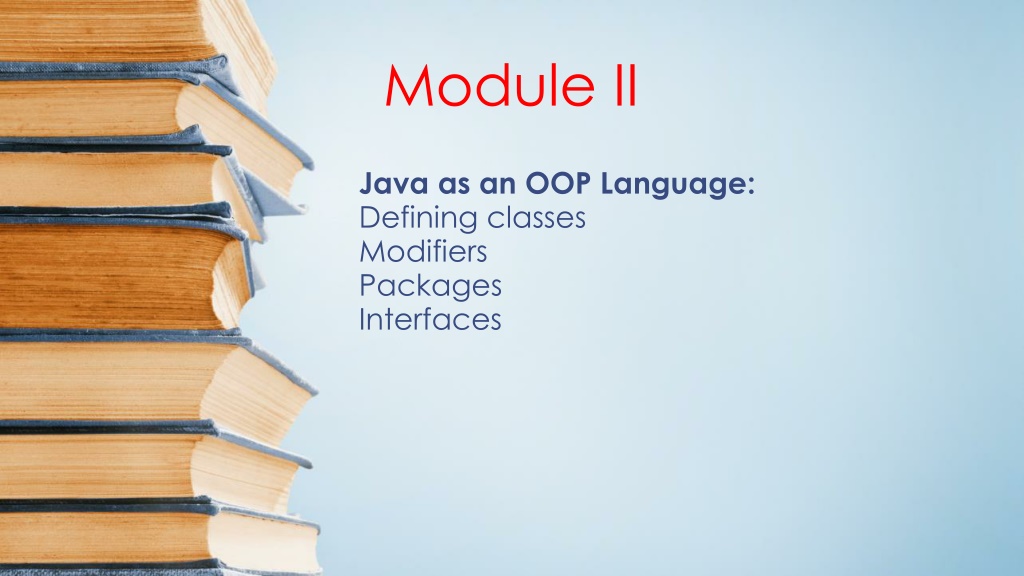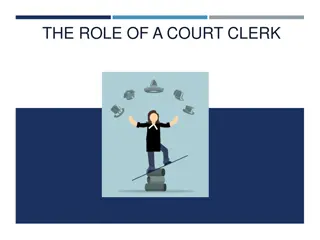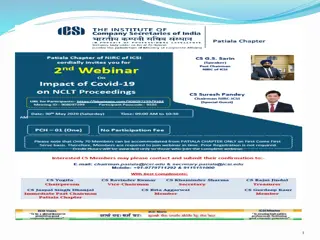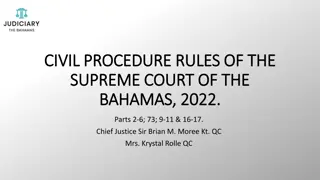Guidelines for Proceedings Publication
This guide outlines the process for publishing proceedings volumes, including author submissions, peer review, writing a preface, and submitting to Atlantis Press. Follow these steps to enhance the publication process and ensure timely indexing.
Download Presentation

Please find below an Image/Link to download the presentation.
The content on the website is provided AS IS for your information and personal use only. It may not be sold, licensed, or shared on other websites without obtaining consent from the author.If you encounter any issues during the download, it is possible that the publisher has removed the file from their server.
You are allowed to download the files provided on this website for personal or commercial use, subject to the condition that they are used lawfully. All files are the property of their respective owners.
The content on the website is provided AS IS for your information and personal use only. It may not be sold, licensed, or shared on other websites without obtaining consent from the author.
E N D
Presentation Transcript
Module II Java as an OOP Language: Defining classes Modifiers Packages Interfaces
Introduction Java is a true object oriented language and therefore the underlying structures of all java programs is classes. Anything we wish to represent in a java program must be encapsulated in a class that defines the state and behavior of the basic programs known as objects. Classes create objects and objects use methods to communicate between them. That is all about object-oriented programming.
Classes provide a convenient method packing together a group of logically related data items and functions that work on them. In Java, the data items are called fields and functions are called methods. Calling a specific object is described as sending the object a message. A class is essentially a description of how to make an object that contains fields and methods. It provides a sort of template for an object and behaves like a basic data type such as int.
Java supports the following fundamental concepts Polymorphism Inheritance Encapsulation Abstraction Classes Objects Instance Method Message Passing
Class A class is a user defined blueprint or prototype from which objects are created. It represents the set of properties or methods that are common to all objects of one type. In general, class declarations can include these components, in order: Modifiers : A class can be public or has default access Class name: The name should begin with a initial letter (capitalized by convention). Superclass(if any): The name of the class s parent (superclass), if any, preceded by the keyword extends. A class can only extend (subclass) one parent. Interfaces(if any): A comma-separated list of interfaces implemented by the class, if any, preceded by the keyword implements. A class can implement more than one interface. Body: The class body surrounded by braces, { }.
Defining a class Syntax : class classname [extends Superclassname] { [Field declarations;] [Method declarations;] }
Field Declaration Data is encapsulated in a class by spacing data fields inside the body of class definition. These variables are called instance variables because they are created whenever an object of the class in instantiated. It is also known as member variables. We can declare the instance variable exactly the same way as we declare local variables. Example class rectangle { int length; int width; }
Methods Declaration A class with only data fields has no life. The object created by such a class cannot respond to any messages. We must therefore add methods that are necessary for manipulating the data contained in the class. Methods are declared inside the body of the class but immediately after the declaration of instance variable. General Form Type methodname (parameter list) { Method body; }
Method declarations have four basic parts The name of the method The type of the value the method returns. A list of parameters The body of the method
Objects It is a basic unit of Object Oriented Programming and represents the real life entities. A typical Java program creates many objects, which as you know, interact by invoking methods. An object consists of : State : It is represented by attributes of an object. It also reflects the properties of an object. Behavior : It is represented by methods of an object. It also reflects the response of an object with other objects. Identity : It gives a unique name to an object and enables one object to interact with other objects. Objects correspond to things found in the real world. For example, a graphics program may have objects such as circle , square , menu . An online shopping system might have objects such as shopping cart , customer , and product .
Declaring Objects (Also called instantiating a class) When an object of a class is created, the class is said to be instantiated. All the instances share the attributes and the behavior of the class. But the values of those attributes, i.e. the state are unique for each object. A single class may have any number of instances.
Creating Objects An object in Java is essentially a block of memory that contains space to store all the instance variables. Creating a object is also referred to as instantiating object. Objects in Java are created using the new operator. Syntax : Classname objectname= new Classname(); Example : Box mybox=new Box();
Accessing class members We cannot access the instance variables and the methods directly. To do this , we must use the concerned object and the dot operator as shown below; Objectname.variablename=value; Objectname.methodname(parameter-list);
class objdemo { void display() { System.out.println("method is accessed"); } public static void main(String ar[]) { objdemo ob=new objdemo(); ob.display(); } }
Constructors In Java, a constructor is a block of codes similar to the method. It is called when an instance of the class is created. At the time of calling constructor, memory for the object is allocated in the memory. It is a special type of method which is used to initialize the object. Every time an object is created using the new() keyword, at least one constructor is called. It calls a default constructor if there is no constructor available in the class. In such case, Java compiler provides a default constructor by default. There are two types of constructors in Java: no-arg constructor, and parameterized constructor. Note: It is called constructor because it constructs the values at the time of object creation. It is not necessary to write a constructor for a class. It is because java compiler creates a default constructor if your class doesn't have any.
Rules for creating Java constructor There are two rules defined for the constructor. 1. Constructor name must be the same as its class name 2. A Constructor must have no explicit return type 3. A Java constructor cannot be abstract, static, final, and synchronized
Difference between constructor and method in Java Java Constructor Java Method A constructor is used to initialize the state of an object. A method is used to expose the behavior of an object. A constructor must not have a return type. A method must have a return type. The constructor is invoked implicitly. The method is invoked explicitly. The Java compiler provides a default constructor if you don't have any constructor in a class. The method is not provided by the compiler in any case. The constructor name must be same as the class name. The method name may or may not be same as the class name.
Static members static keyword can be used with class, variable, method and block. Static members belong to the class instead of a specific instance, this means if you make a member static, you can access it without object. Static members are common for all the instances(objects) of the class but non-static members are separate for each instance of class. Static Block Static block is used for initializing the static variables.This block gets executed when the class is loaded in the memory. A class can have multiple Static blocks, which will execute in the same sequence in which they have been written into the program.
Static Variables static variable is common to all the instances (or objects) of the class because it is a class level variable. In other words you can say that only a single copy of static variable is created and shared among all the instances of the class. Memory allocation for such variables only happens once when the class is loaded in the memory. Note Static variables are also known as Class Variables. Unlike non-static variables, such variables can be accessed directly in static and non-static methods.
Static Methods Static Methods can access class variables(static variables) without using object(instance) of the class, however non-static methods and non-static variables can only be accessed using objects. Static methods can be accessed directly in static and non-static methods. Static Class A class can be made static only if it is a nested class. Nested static class doesn t need reference of Outer class A static class cannot access non-static members of the Outer class
Inheritance (IS-A relationship) The process by which one class acquires the properties(data members) and functionalities(methods) of another class is called inheritance. The aim of inheritance is to provide the reusability of code so that a class has to write only the unique features and rest of the common properties and functionalities can be extended from the another class. Child Class: The class that extends the features of another class is known as child class, sub class or derived class. Parent Class: The class whose properties and functionalities are used(inherited) by another class is known as parent class, super class or Base class.
Inheritance is a process of defining a new class based on an existing class by extending its common data members and methods. Inheritance allows us to reuse of code, it improves reusability in your java application. Advantage of Inheritance is that the code that is already present in base class need not be rewritten in the child class. This means that the data members(instance variables) and methods of the parent class can be used in the child class as. Syntax : class subclassname extends superclassname { variable declaration; methods declaration; }
Types of inheritance 1) Single Inheritance Single inheritance is damn easy to understand. When a class extends another one class only then we call it a single inheritance. The below flow diagram shows that class B extends only one class which is A. Here A is a parent class of B and B would be a child class of A. Class A Class B
2) Multiple Inheritance Multiple Inheritance refers to the concept of one class extending (Or inherits) more than one base class. The inheritance we learnt earlier had the concept of one base class or parent. The problem with multiple inheritance is that the derived class will have to manage the dependency on two base classes. Multiple Inheritance is very rarely used in software projects. Using Multiple inheritance often leads to problems in the hierarchy. This results in unwanted complexity when further extending the class. Class B Class A Class C
Multilevel Inheritance Multilevel inheritance refers to a mechanism in OO technology where one can inherit from a derived class, thereby making this derived class the base class for the new class. Class A Class B Class C
Hierarchical Inheritance In such kind of inheritance one class is inherited by many sub classes.
Hybrid Inheritance In simple terms you can say that Hybrid inheritance is a combination of Single and Multiple inheritance.
Polymorphism Polymorphism is the capability of a method to do different things based on the object that it is acting upon. In other words, polymorphism allows you define one interface and have multiple implementations.
Method Overloading If a class has multiple methods having same name but different in parameters, it is known as Method Overloading. If we have to perform only one operation, having same name of the methods increases the readability of the program. Advantage of method overloading Method overloading increases the readability of the program. There are two ways to overload the method in java By changing number of arguments By changing the data type
class DisplayOverloading { public void disp(char c) { System.out.println(c); } public void disp(char c, int num) { System.out.println(c + " "+num); } } class Sample { public static void main(String args[]) { DisplayOverloading obj = new DisplayOverloading(); obj.disp('a'); obj.disp('a',10); } }
Method overriding Declaring a method in sub class which is already present in parent class is known as method overriding. Overriding is done so that a child class can give its own implementation to a method which is already provided by the parent class. In this case the method in parent class is called overridden method and the method in child class is called overriding method. Advantage of method overriding class can give its own specific implementation to a inherited method without even modifying the parent class code.
Method Overriding and Dynamic Method Dispatch Method Overriding is an example of runtime polymorphism. When a parent class reference points to the child class object then the call to the overridden method is determined at runtime, because during method call which method(parent class or child class) is to be executed is determined by the type of object. This process in which call to the overridden method is resolved at runtime is known as dynamic method dispatch. Rules of method overriding in Java Argument list: The argument list of overriding method (method of child class) must match the Overridden method(the method of parent class). The data types of the arguments and their sequence should exactly match. Access Modifier of the overriding method (method of subclass) cannot be more restrictive than the overridden method of parent class. For e.g. if the Access Modifier of parent class method is public then the overriding method (child class method ) cannot have private, protected and default Access modifier,because all of these three access modifiers are more restrictive than public. For e.g. This is not allowed as child class disp method is more restrictive(protected) than base class(public)
final variables and methods All methods and variables can be overridden by default in subclasses If we wish to prevent the subclasses from overriding the members of superclass,we can declare them as final using the keyword final as modifier. Making a method final ensures that the functionality defined in this method will never be altered in anyway. Similiarly the value of final variable can never be changed.
Final classes When a class is declared with final keyword, it is called a final class. A final class cannot be extended(inherited). There are two uses of a final class : 1. One is definitely to prevent inheritance, as final classes cannot be extended. For example, all Wrapper Classes like Integer,Float etc. are final classes. We can not extend them. 2. The other use of final with classes is to create an immutable class like the predefined String class.You can not make a class immutable without making it final.
Abstract methods Sometimes, we require just method declaration in super-classes. This can be achieve by specifying the abstract type modifier. These methods are sometimes referred to as subclasser responsibility because they have no implementation specified in the super-class. Thus, a subclass must override them to provide method definition. Syntax :abstract type method-name(parameter-list);
Finalizer methods Constructor method is used to initialize an object when it is declared.This process is known as initialization. Similiarly ,Java supports a concept called finalization,which is just opposite to initialization. Java runtime is an automatic garbage collecting system.It automatically frees up the memory resources used by the objects. But the object may hold other non object resources such as file descriptors etc.The garbage collector cannot free these resources. Inorder to free these resources we must use a finalizer method which is similar to destructor in C++. Syntax : finalize();
Abstract Class A class that is declared using the abstract keyword is known as an abstract class. The main idea behind an abstract class is to implement the concept of Abstraction. An abstract class can have both abstract methods(methods without body) as well as the concrete methods(regular methods with the body). However, a normal class(non-abstract class) cannot have abstract methods.
Example abstract abstract class Book { class Book { public abstract void page(); public abstract void page(); } } public public class class abs extends abs extends Book { Book { // Declaring the abstract method // Declaring the abstract method public void page() public void page() { { System.out.println System.out.println("Geek"); ("Geek"); } } public static void main(String public static void main(String args args[]) []) { { Book Book obj obj = new = new abs(); abs(); obj.page obj.page(); (); } }
Difference between abstract class and final class S.NO. ABSTRACT CLASS FINAL CLASS 1. Uses the abstract key word. Uses the final key word. This helps to restrict other classes from accessing its properties and methods. 2. This helps to achieve abstraction. Overriding concept does not arise as final class cannot be inherited All methods should have implementation For later use, all the abstract methods should be overridden 3. A few methods can be implemented and a few cannot 4. Cannot create immutable objects (infact, no objects can be created) Immutable objects can be created (eg. String class) 5. Abstract class methods functionality can be altered in subclass Final class methods should be used as it is by other classes 6. 7. 8. Can be inherited Cannot be instantiated Cannot be inherited Can be instantiated
Visibility control (visibility access) in Java (or) Access modifiers It is possible to inherit all the members of a class by a subclass using the keyword extends. The variables and methods of a class are visible everywhere in the program. However, it may be necessary in some situations we may want them to be not accessible outside. We can achieve this in Java by applying visibility modifiers to instance variables and methods. The visibility modifiers are also known as access modifiers. Access modifiers determine the accessibility of the members of a class.
Java provides three types of visibility modifiers: public, private and protected. They provide different levels of protection as described below. Public Access: Any variable or method is visible to the entire class in which it is defined. But, to make a member accessible outside with objects, we simply declare the variable or method as public. A variable or method declared as public has the widest possible visibility and accessible everywhere. Friendly Access (Default): When no access modifier is specified, the member defaults to a limited version of public accessibility known as "friendly" level of access. The difference between the "public" access and the "friendly" access is that the public modifier makes fields visible in all classes, regardless of their packages while the friendly access makes fields visible only in the same package, but not in other packages.
Protected Access: The visibility level of a "protected" field lies in between the public access and friendly access. That is, the protected modifier makes the fields visible not only to all classes and subclasses in the same package but also to subclasses in other packages Private Access: private fields have the highest degree of protection. They are accessible only with their own class. They cannot be inherited by subclasses and therefore not accessible in subclasses. In the case of overriding public methods cannot be redefined as private type. Private protected Access: A field can be declared with two keywords private and protected together. This gives a visibility level in between the "protected" access and "private" access. This modifier makes the fields visible in all subclasses regardless of what package they are in. Remember, these fields are not accessible by other classes in the same package.
Packages A java package is a group of similar types of classes, interfaces and sub-packages. Package in java can be categorized in two form, built-in package and user-defined package. There are many built-in packages such as java, lang, awt, javax, swing, net, io, util, sql etc. The default package in java is lang.
Advantage of Java Package Java package is used to categorize the classes and interfaces so that they can be easily maintained. Java package provides access protection. Java package removes naming collision.

 undefined
undefined





















